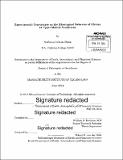| dc.contributor.advisor | William B. Durham. | en_US |
| dc.contributor.author | Dixon, Nathaniel Adams | en_US |
| dc.contributor.other | Massachusetts Institute of Technology. Department of Earth, Atmospheric, and Planetary Sciences. | en_US |
| dc.date.accessioned | 2014-10-08T15:22:28Z | |
| dc.date.available | 2014-10-08T15:22:28Z | |
| dc.date.copyright | 2014 | en_US |
| dc.date.issued | 2014 | en_US |
| dc.identifier.uri | http://hdl.handle.net/1721.1/90682 | |
| dc.description | Thesis: Ph. D. in Geophysics, Massachusetts Institute of Technology, Department of Earth, Atmospheric, and Planetary Sciences, 2014. | en_US |
| dc.description | Cataloged from PDF version of thesis. | en_US |
| dc.description | Includes bibliographical references. | en_US |
| dc.description.abstract | Since the discovery of plate tectonics, geophysicists have sought to understand the dynamic system driving the evolution of the earth, both at the surface and in the deep interior. While the deep earth contains far fewer phases than the crust, the inaccessibility of the mantle and core present a different challenge: unraveling the physical behavior of materials at conditions beyond our intuitive, observational, and experimental grasp. Among the most persistent of problems has been determining the influence of pressure on the mechanical behavior of deep rocks. Deformation experiments have typically been limited by equipment capabilities to only a tiny fraction of the pressure of the deep mantle, and thus our understanding pressure effect on rock strength has remained insufficient to precisely model the convection of the mantle at large scales in time and space. In the last decade, a promising new campaign in mantle rheology has been waged with two powerful emerging technologies: synchrotron x-ray diffraction, and complementary multi-anvil deformation machines. These advancements have allowed precisely controlled deformation experiments at conditions representative of the deep upper mantle, with unprecedented measurement precision. Here I present a detailed experimental study of the behavior of olivine at upper mantle conditions. Among the results is evidence of a significant pressure effect on the strength of olivine (an activation volume of 14 ± 3 cm3/mol), as well as pioneering in situ measurements of fabric development, slip system transitions, and stress heterogeneity. | en_US |
| dc.description.statementofresponsibility | by Nathaniel Adams Dixon. | en_US |
| dc.format.extent | 125 pages | en_US |
| dc.language.iso | eng | en_US |
| dc.publisher | Massachusetts Institute of Technology | en_US |
| dc.rights | M.I.T. theses are protected by copyright. They may be viewed from this source for any purpose, but reproduction or distribution in any format is prohibited without written permission. See provided URL for inquiries about permission. | en_US |
| dc.rights.uri | http://dspace.mit.edu/handle/1721.1/7582 | en_US |
| dc.subject | Earth, Atmospheric, and Planetary Sciences. | en_US |
| dc.title | Experimental constraints on the rheological behavior of olivine at upper mantle conditions | en_US |
| dc.type | Thesis | en_US |
| dc.description.degree | Ph. D. in Geophysics | en_US |
| dc.contributor.department | Massachusetts Institute of Technology. Department of Earth, Atmospheric, and Planetary Sciences | |
| dc.identifier.oclc | 890659637 | en_US |
